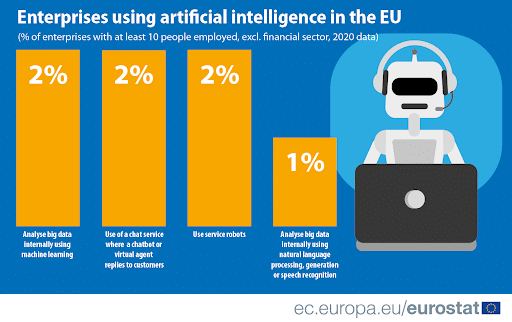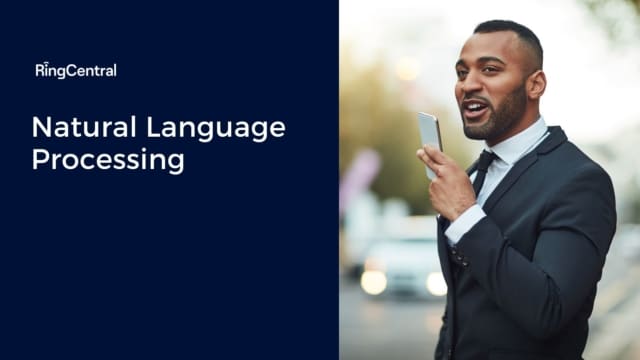Natural Language Processing (NLP) refers to the set of methods that allow computers to understand, read, and derive meaning from human languages. It’s concerned with processing natural languages like English, Spanish, and Mandarin into data from which a computer can derive information.
What is Natural Language Processing (NLP)?
NLP uses text or voice segmentation to break language down into elemental pieces and applies linguistics, algorithms, statistics, and more to understand the raw input, enrich it, draw insights from it, or add value in some way. You might consider natural language processors a form of a language interpreter, like the Python interpreter.
As a branch of Artificial Intelligence (AI), NLP systems have become embedded in our lives over the past two decades. Techniques like machine learning and translation are ubiquitous with the internet and web browsing. At the same time, text classifications, algorithmic, and rule-based tasks are encountered every day in the form of email spam filters.
More recently, voice assistants like Apple’s Siri and Amazon’s Alexa have demonstrated how NLP can be used to write software that lets machines comprehend speech and carry out conversations.
Read on to learn more about this critical technology—its importance, common NLP tasks, techniques used in NLP, where it’s used, and real-world examples.

The importance of NLP
With so much of the world’s information in the form of natural human language, a technology that can understand it offers critical business opportunities.
While the earliest rules-based NLP applications were difficult to scale, today’s statistical programs combine machine and deep learning models. That means they can learn while they work, extracting accurate information from vast quantities of unstructured data in the form of text and voice sources.
Natural language processes now have more extensive real-world applications with greater efficiency, from translations to virtual assistants and chatbots, social media sentiment analysis, and other automated services.
There’s no end to practical, real-world use cases for computer science resources like NLP. Consider how computers that can identify patterns in the written text might be used in the context of legal, due diligence checks, improving both the speed and accuracy of the process. Or how NLP would assist with classifying and organising content relating to products and services to determine consumer spending habits.
In healthcare, NLP systems prove their worth assisting with disease prediction and medical diagnoses by extracting intelligence from countless patient health records. Here, they’re a source of ongoing innovation and are also used in day-to-day information management.
Insofar as they can modernise workflows, improve the accuracy and transparency of information exchange, and streamline administrative processing, NLP systems can have a transformative effect on the way businesses and organisations function.

Common NLP tasks
1. Speech recognition
Natural Language Processing can be used to perform tasks in conjunction with speech and text recognition engines, making speech recognition less time consuming and allowing more practical use cases.
Automatic speech recognition (ASR) allows computers to understand spoken words and convert them into text data. When NLP is applied, computational linguistics can further understand and even respond to human language.
Take, for example, a spoken dialogue system like a voice assistant on mobile devices or a conversational IVR. These require tools for ASR to understand what a human says. And NLP extract details from the speech to determine what the human wants performs the activity requested and conveys the information to the human.
With deep learning models, modern-day assistants like Siri and Alexa can map sound signals and sequence human language sounds and words to make sense of tasks and carry out corresponding functions, like question answering.
2. Speech tagging
Speech tagging or grammatical tagging is the essence of natural language understanding. It refers to an NLP process whereby machines can interpret context-dependent language.
For example, in English, words can be both verbs and nouns. Determining the meaning of a word relies on its context. Take the word “watch”. The sentences “I’m wearing a watch” and “please watch the presentation” assign the word entirely different meanings. To provide any useful application, a machine has to interpret the word based on its use.
Automatic part-of-speech tagging (POS) enables a system to categorise words while retaining their syntax dependent meaning. Words in a text are marked as corresponding to a particular part of speech based on context, definition, and how they relate to a surrounding sentence or phrase.
Think of it as how you begin to learn a language in primary school, identifying verbs, nouns, and adjectives from sentences on an activity sheet. An NLP system works in the same way, gaining intelligence through big data fields.

3. Word sense disambiguation
Word sense disambiguation (WSD) is another way natural word processing determines or classifies the sense of a word.
It increases the success of NLP applications like translation and information retrieval by selecting the correct use of a word, occurring in a specific context. From the surrounding linguistic context and manufactured data sets and lexical resources, NLP systems can look for clues to the meaning of a word.
Within word sense disambiguation, text normalising procedures like stemming and lemmatization work to prepare the text for processing. Here, a word will be reduced to its core root to improve search results and reduce dimensionality (i.e., limit the number of data sets or unstructured text that’s searched).
Named entity recognition works alongside WSD to identify words or phrases that might be useful entities. For example, it would detect the name of places like “London”, personal names like “Fred”, and business names like “LinkedIn”.
4. Sentiment analysis
Sentiment analysis is a form of NLP that you’ll have encountered if you run a business that provides customer support and uses contact centre products for reporting and analytics.
The best call analytics tools will use sentiment analysis to understand how customers feel when discussing specific topics.
Essentially, it’s a natural language process whereby machine learning methods will extract quantifiable information from subjective things like attitude, emotion, and opinions based on the tone of text or speech.
5. Natural language generation
Natural language generation refers to the software process that creates natural language output.
It can transform unstructured data into language data using computational linguistics, NLP, and natural language understanding (NLU). This transforms into natural-sounding speech or responses for use in technologies like voice assistants and chatbots and can also generate scripts for customer service use.
NLP can train language models and produce robust end-to-end systems that interpret natural-language input and produce natural-looking text output with deep learning neural networks. Essentially, this means an AI system can be trained to write or read sentences like a human.

Techniques used in NLP
1. Syntax techniques
Natural Language Processing uses data science techniques and algorithms to process syntax techniques and grammatical rules, much like humans in the early stages of learning a language.
Just like children might break a sentence down to understand its parts, NLP applications use word segmentation and sentence breaking to categorise words and derive meaning from them.
Techniques like parsing are employed here to check text meaning against grammar rules. Each word would be broken down into a grammar rule within a sentence, creating phrase structure trees to understand which words are the subject or object of a sentence.
2. Semantics techniques
Semantics refers to the meaning conveyed by language as far as NLP’s are concerned; semantic techniques are constantly being reassessed and improved with every new iteration of NLP applications.
With the advent of social media, NLP systems have been granted a new data source for understanding semantics. Using web-scraping techniques, NLP researchers can collect data on language use and social interactions from various forums, web pages, and discussion boards to become more semantically precise.
Using the processes discussed above, like word sense disambiguation and named entity recognition, alongside the mining of internet sources, has allowed NLP systems to understand semantics.
However, there will still need to be significant natural language processing before voice recognition software, and dialogue systems like Siri can understand sarcasm.
Where is Natural Language Processing used?
1. Machine language translation
Machine translation or MT systems translate one natural human language into another. The translation is a common NLP task with systems like Google Translate employing natural language processes to automate translations between over 100 languages.
With the help of NLP systems, translation programs have improved substantially over the last few years, with more accurate word choices and more precise grammar. The text input language is now automatically detected, and word alternatives are offered based on common phrases.

2. Spam detection
One of Natural Language Processing’s simplest and most effective uses is filtering spam for better online security. Here, text in messages is classified and filtered according to the words found. The assumption here is that some words are more spam-like than others.
As the number of online content sharing applications increases, NLP powered spam filters are becoming more advanced in the techniques they implement to detect junk.
Alongside word indicators, syntax indicators like a discontinuous text flow are being employed to sort messages. Machine learning algorithms can also be written for topic detection, identifying irrelevant comments to the place they’re posted.
3. Chatbots and virtual assistants
Text-based NLP chatbots have replaced rule-based chatbots. They provide an automated customer service that carries information between conversations, saving relevant data and informing future interactions with the same customer.
NLP chatbots work to help users perform routine tasks by understanding messages and responding with the appropriate information.
The most advanced NLP bots will even understand the intent of a message, ensuring it’s delivering the most successful service to customers. For example, if a business has created a chatbot to help its customers with order management, the chatbot should infer user problems like delayed orders without specific language being used.
4. Word processors
Word processors like Microsoft Word and Grammarly employ NLP to check grammar and spelling. Here, machine learning and deep learning use pattern-matching techniques to find and correct grammatical errors. The larger the quantity of training data, the more effective the program can spot mistakes and suggest possible remedies.
Since grammar and spelling checkers were first developed in the 1970s, they’ve made considerable progress. Today’s systems can even use Natural Language Processing to detect the incorrect usage of words by assessing the context in which they’re used.
For example, most English grammar checkers can use speech tagging and word sense disambiguation to spot and correct the incorrect effect and affect.

5. Interactive Voice Response (IVR)
Interactive Voice Response systems or IVR allow humans to interact with computer-operated phone systems via voice or keyboard input. Natural language processes are used here to interpret speech and understand why a caller might be reaching out.
With NLP, the caller can state their issue in various ways and still be understood, rather than having to be prompted to say particular words or phrases. The system should then recognise the caller’s intent and take the necessary actions.
IVR can streamline call handling and offer a friction-free customer experience by providing instant query resolution and self-help options. Not only this, but they can reduce contact centre costs and improve their overall efficiency.
Examples of Natural Language Processing
1. Search results
Search engines use Natural Language Processing to bring up relevant pages based on the intent of the average search engine user and previous similar search behaviours. The accuracy of results is improved the better the search engine’s understanding of words and how they function in a sentence.
NLP enables users to input quick search terms and find what they’re looking for without entering exact words and phrases. As NLP improves its semantic capabilities, search engines are becoming even more intuitive.
Nowadays, you can enter a maths problem into Google, and it will return the correct answer or enter a flight path, and it’ll show you the next available flight from your local airport.
2. Predictive text
Predictive text, next-word prediction, auto-correct, and auto-complete have fast become the norm on mobile devices. Like search engines, they use Natural Language Processing to predict typing based on past uses.
The task of a prediction model is to present word options with the highest probability of next use based on the usual pattern. For example, if you’re using a messaging app and often follow “good” with “morning”, the word suggestion feature will recommend “morning” the next time NLP detects “good” is used in the same semantic and syntactic context.
Autocorrect will even work to remodel your sentences and eliminate typos based on your usual word choices alongside conventional usage, traditional spelling, and grammar.

3. Data analysis
Natural Language Processing offers new and more convenient opportunities to incorporate data analysis into everyday business interactions and workflows. With the ability to understand human speech, data and analytics like performance indicators can be pulled straight from live speech.
For example, if you’re managing a call centre, you can monitor call quality and assess customer issues in real-time. Business intelligence tools that incorporate NLP into tasks like issue prediction can alert you to problems immediately and collect data from natural language.
In the past, business intelligence analytics powered by data analytics necessitated professionals to alter data collection methods and interpret results. With NLP, analytics can now be gathered and are readily available right from your desktop. The best solutions will even present your KPIs and insights through an easy to use analytics portal.
4. Text analytics
Text analytics work to transform unstructured text into data for valuable insights. Using linguistic techniques and machine learning, raw speech can be assessed for important business insights.
With sentiment analysis, for example, NLP can assess live customer interactions. Alternatively, it can scour social media comments for brand mentions and evaluate your company reputation or judge customer reviews to determine the success of a product launch.
Keyword extractions can help find patterns in raw data and supply businesses with important metrics without creating their own data pools.
Integrate NLP into your contact centre with RingCentral
NLP has many applications in the business world, offering insights based on language data and improving the efficiency of workflows with streamlined human to computer interactions that can solve customer issues faster than ever before.
Don’t wait to incorporate NLP into your customer service provisions. With RingCentral, you can move beyond basic communications and enhance the customer experience.
With NLP poised for future growth, RingCentral will make sure your business stays ahead of the curve.
Originally published Aug 24, 2021, updated Feb 14, 2024


